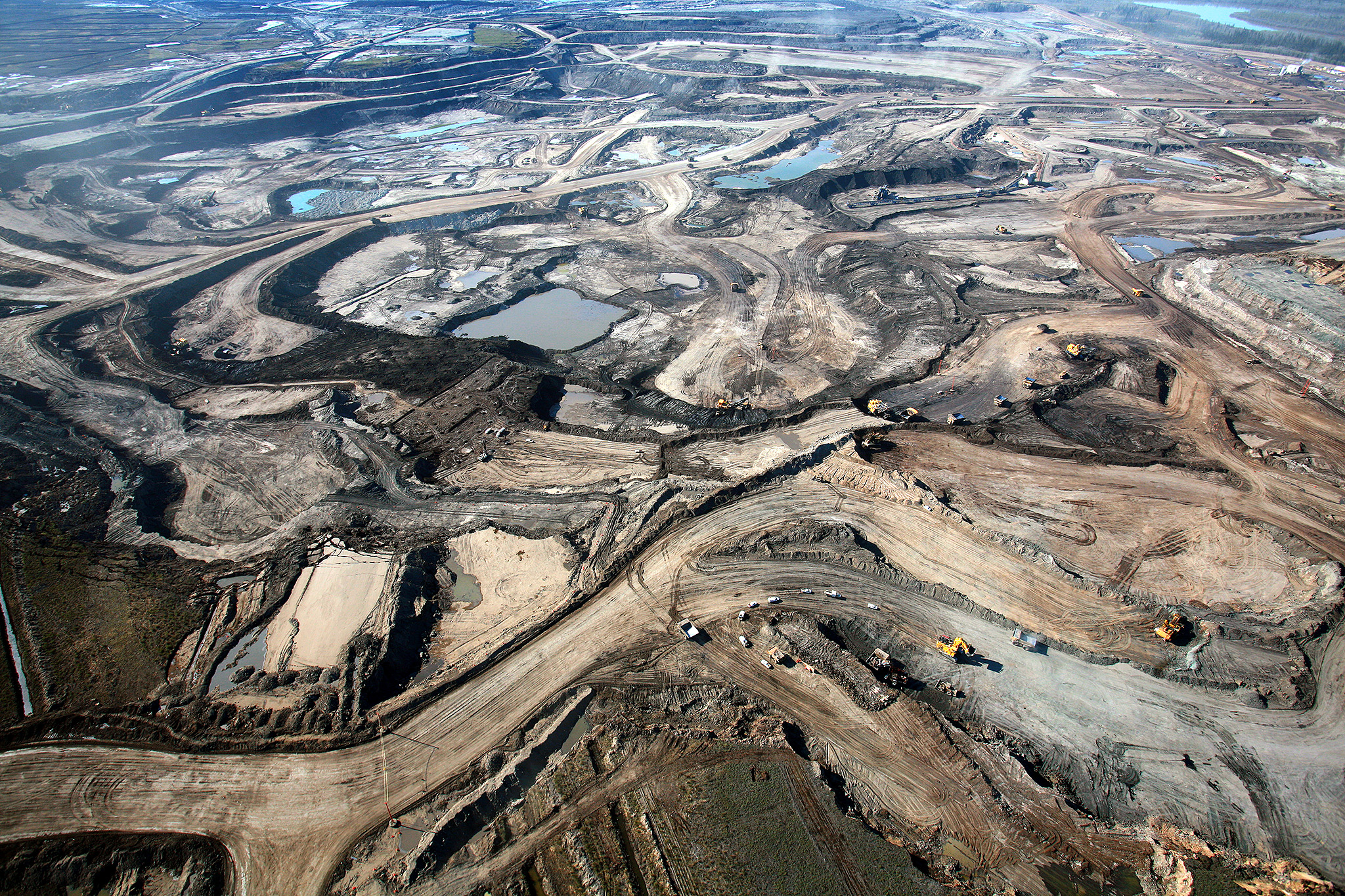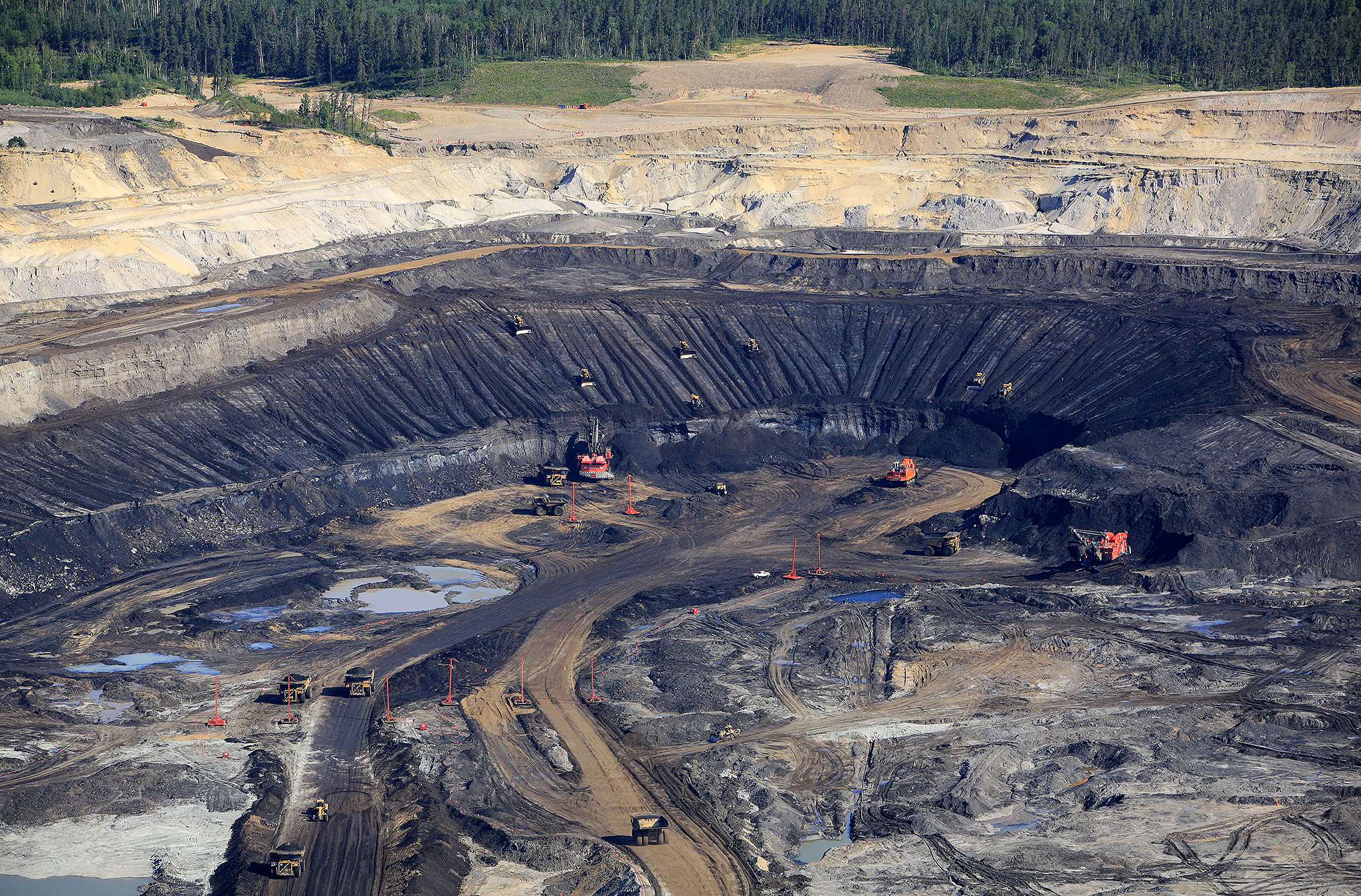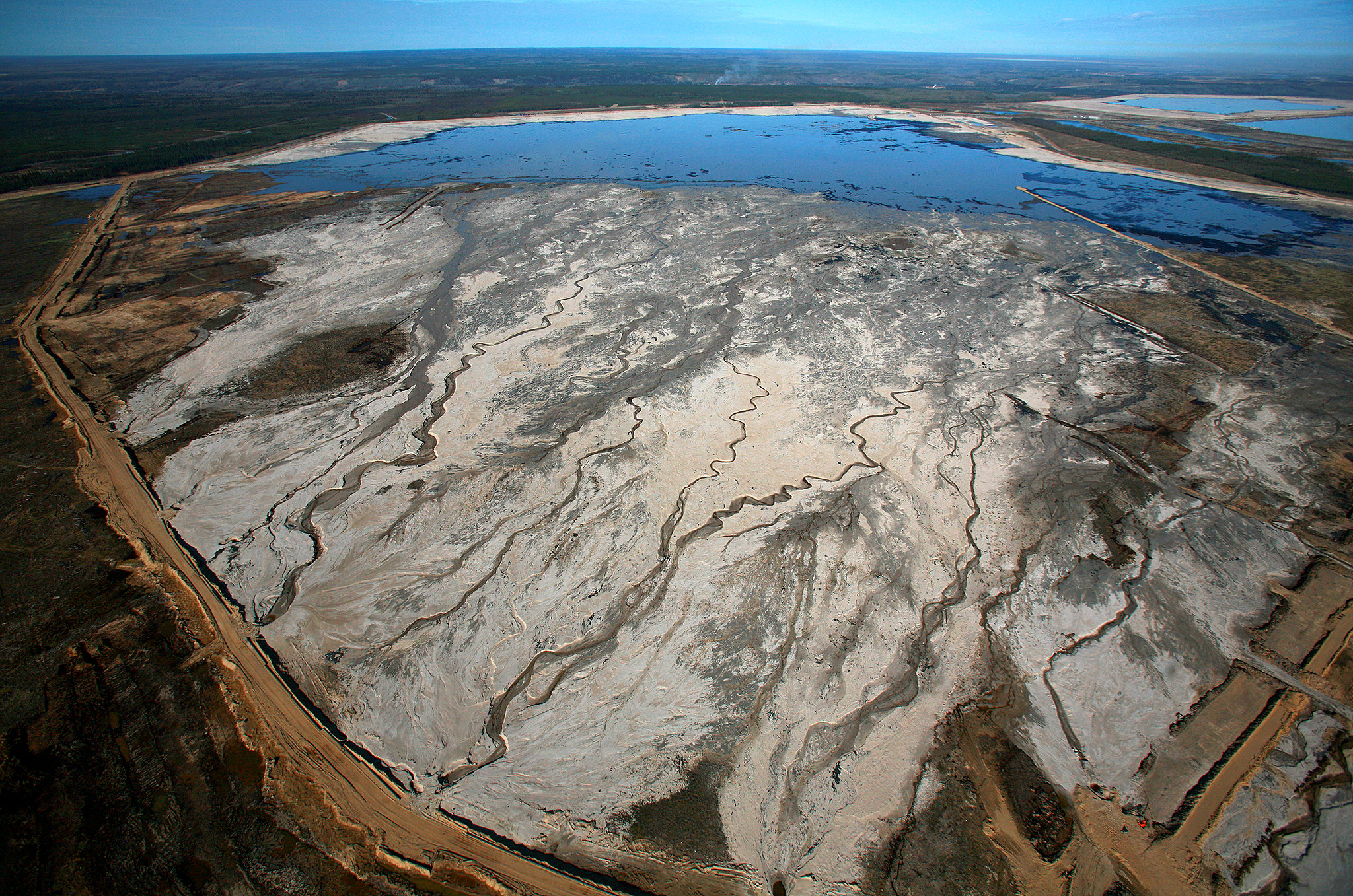Alberta Tar Sands
Location:
CanadaProject risks:
Environmental Destruction, Social HarmCompanies:
- China National Petroleum Corporation (CNPC)
- China National Offshore Oil Corporation
- PetroChina Company Ltd
- Exxon Mobil Corporation
- Shell plc
- CNOOC Ltd
- ConocoPhillips
- Canadian Natural Resources Ltd (CNRL)
- Suncor Energy Inc
- China Petrochemical Corporation (Sinopec Group)
- Cenovus Energy Inc
- Imperial Oil Ltd
- Korea National Oil Corporation (KNOC)
- MEG Energy Corp
- Athabasca Oil Corporation
- Strathcona Resources Ltd
- Waterous Energy Fund
- Connacher Oil And Gas Ltd
- International Petroleum Corporation (IPC)
- Greenfire Resources Ltd
Approximate location. By zooming in, you can recognize the open mine pits and tailing ponds of the tar sands companies.
One of the Dirtiest Project on Earth
Alberta's tar sands oil extraction is one of the dirtiest projects on Earth.14401 Most of Canada’s oil comes from tar sands that lie beneath an area larger than England.14391 In 2013 it was estimated that if all of Alberta's tar sands oil were burned, global temperatures would rise by 0.4 °C (32.7°F).14393 This alone would take our world beyond the critical 1.5 °C limit.
To get to the oil, Canadian Natural Resources (CNRL), Suncor Energy, Cenovus Energy, ExxonMobil, Imperial Oil and others are destroying Canada’s ancient boreal forest. Large deposits of Canada’s tar sands are located underneath the trees. Tar sands are a mix of tar, clay, sands and bitumen, an unconventional type of oil.14395 Oil companies get the bitumen out of the ground by mining it from the surface or extracting it from deep underground.14397 In more than half of Alberta, the bitumen lies so deep in the ground that they must drill wells and inject steam to extract it.14399 To get to the shallow layers, oil companies raze down forests and blast away the fertile topsoil. In their quest for oil, more than 20 companies are draining wetlands and changing the natural course of Alberta’s rivers and streams. They leave behind large lakes of poisonous waste and gigantic open mine pits over thousands of square miles of destroyed landscape.14403
Note: Reputational risk projects on GOGEL are updated annually. This article was last updated November 4 2025.

Impacts on Health and Environment
Before the bulldozers came, Canada’s boreal forest made up 25 percent of the Earth’s remaining intact forests.14405 The boreal forest stretches across northern Alaska, Canada, Northern Europe and Russia.14407 Unknown to many, it is not a uniform forest, rather a patchwork of coniferous and hardwood forests, wetlands, rivers and lakes. The huge amount of carbon the forest stores make it a life-support system for the planet.14409 Boreal forests hold almost twice as much carbon as rainforests do.[1] Over thousands of years, the forest has stored carbon in its trees, its wetlands and deep in permafrost soil. As oil and gas companies cut down the ancient trees, they release huge amounts of carbon into the atmosphere.14413 James Hansen, Director of the NASA Goddard Institute for Space Studies says: “If Canada proceeds, and we do nothing, it will be game over for the climate."14415

When ExxonMobil, Suncor and other companies mine the oil, they produce toxic waste referred to as tailings. These tailings are a slurry of water, fine sand particles, chemicals, heavy metals and other petrochemical waste.14417 Oil companies are dumping this poison into enormous human-made lakes called tailing ponds.14419 The so-called ponds together take up an area of 300 square kilometers, enough to cover the city of Vancouver 2.6 times over.19518 Alberta’s tar sands companies have produced more than 2 trillion liters of poisonous tailings.19520 And the toxic lakes are growing day by day.14423
Tailing ponds make people ill. They are full of poisons such as lead, arsenic, benzene and mercury.14425 The chemicals cause nervous system damage, higher rates of cancer and rare types of childhood cancer. 14427 When oil producers aren't injecting it underground, the slurry from tailing ponds continuously seeps into Alberta’s groundwaters, lakes and rivers.144291443119521 Even as far as 200 km (124 mi) away from the Alberta extraction sites, cancer rates have increased by 30 percent.[2] The disposal of wastewaters by injecting them underground can cause significant earthquakes.15421 The industry’s typically slow responses to leaks do not help either. In 2022, it took Imperial Oil half a year to identify the source of a leak form one of its tailing ponds.15425 Nine months later, the same company was linked to one of the largest wastewater leaks in Alberta’s history.1542314435 In 2024, Athabasca Chipewyan First Nation filed a lawsuit against Alberta’s Energy Regulator (AER) for not having been informed about toxic discharges into their territorial watershed earlier.1952919531 After years of tireless work of Indigenous communities and environmental organizations, AER officially laid charges against Imperial Oil almost two years after the spill.2337823379
The tar sands companies have turned the air, water and land of Indigenous First Nations into a sacrifice zone.14437 New research shows that health-damaging carbon emissions exceed industry-reported values by up to 6300%.19536 The findings reinforce similar claims Indigenous communities have been making for decades.19535 The companies have used so much water for oil production that water levels have become dangerously low.14439 The few fish people are still able to catch are too contaminated to eat.14441 Many Indigenous communities are struggling to make enough money to survive.14443 People are often left with no choice but to work for the industry that has destroyed the land and waters they depend on.14445 The Beaver Lake Cree Nation keeps fighting a legal battle to stop the ever-hungry tar sands expansionists.15429 35,000 oil and gas sites are eating away at Indigenous Nation's water and lands, as well as their rights to fish, hunt and gather plants.1444715431 For this reason, the people of Beaver Lake Cree Nation have decided to sue the governments in Canada and Alberta that authorized the tar sands mines and other destructive industrial projects on the Nation’s traditional lands.14449 Their goal is clear. They do not want to stop one specific mine, project or company, but “all of them at once”.14451

Government Greenwashing
For decades, First Nations and environmental groups both in Canada and the US have criticized and challenged tar sands pipelines due to leaks and environmental damage. The Canadian government reacted to the criticism by actively promoting pipelines and tar sands as safe, reliable and responsible. Altogether, it has spent USD 30 million of tax payers’ money on pro-pipeline and tar sands advertising campaigns.14453
The Canadian government’s rhetoric isn’t fooling anybody. For years, UNESCO has debated placing the adjacent Wood Buffalo National Park on the “World Heritage in Danger” list. The UN body has made three requests to Canada’s government to conduct a risk assessment on the impacts of tailings ponds and tar sand production on the UNESCO-recognized World Heritage Site.15433 These remain unanswered.15435 In the meantime, the park’s condition continues to deteriorate, tailings continue to seep into the watershed, and the Albertan landscape continues to be shredded apart – all so that oil and gas profits can continue flowing.15437
Banks: Masters of Hypocrisy
Banks are coming under increasing pressure to stop funding tar sands companies. Standard Chartered, Deutsche Bank, Crédit Agricole and others have said that they will no longer finance tar sands projects. However, they continue to give unspecified loans to the exact same tar sands companies.14455 In this way, these companies can still use the money for their tar sands projects. Supporting one of the dirtiest projects on earth in the middle of the climate crisis is a huge reputational risk for any financial institution.
“Our ancestors have lived on these lands for thousands of years and the decimation of the land, air, water, vegetation in the past 40 years of tar sands mining is the worst any industrialized country has seen ever. Worst case for our people living downstream is the multitude of rare cancers we are living and dying with while the governments continue to give approvals for further development.”
George J. Poitras, Former Chief of the Mikisew Cree First Nation[3]
Groups working on Alberta Tar Sands: Above Ground, Rainforest Action Network, Climate Action Network, RAVEN Trust, Greenpeace, Environmental Defence, Indigenous Environmental Network, International Treaty Organization, Sierra Club, Concerned Scientists, David Suzuki Foundation, The Natural Resources Defense Council, Earth Works, Amnesty International, Canadian Wilderness Committee, Ducks Unlimited, BankTrack, Oil Change International, Stop Line 3, Treaty Alliance Against Tar Sands Expansion, 350org
Sources:
Further Reading:
https://environmentaldefence.ca/report/report-reality-check-water-and-the-tar-sands/
https://www.nrdc.org/sites/default/files/TarSandsInvasion-full.pdf
Documentaries:
"Petropolis: Aerial Perspectives on the Alberta Tar Sands": https://www.youtube.com/watch?v=agwTige0dqQ
"Killer Water": https://therealnews.com/killer-water-the-toxic-legacy-of-canadas-oil-sands-indu…